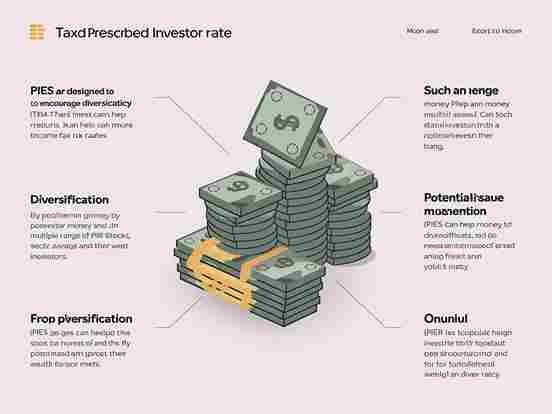What is a Portfolio Investment Entity (PIE)?
A portfolio investment entity, commonly referred to as a PIE, is a type of investment entity designed to simplify tax reporting and offer tax advantages for investors. Established to encourage a diversified investment portfolio, PIEs can include various investment structures such as managed funds, unit trusts, and certain superannuation funds. In countries like New Zealand, PIEs offer a tax-efficient way to invest, with tax rates capped at lower thresholds, making them particularly attractive to a wide range of investors.
Understanding the mechanics of PIEs, including their benefits and restrictions, is essential for investors who want to maximize the advantages of tax-efficient investing. In this article, we’ll cover what PIEs are, their key features, and how they compare to other investment structures.
What is a portfolio investment entity? (H2)
A Portfolio Investment Entity (PIE) is an investment fund or vehicle that pools money from multiple investors to purchase a diversified portfolio of financial assets. This could include stocks, bonds, or other financial instruments. PIEs were introduced to encourage investment in a regulated, tax-effective way that would allow a wide range of investors to benefit from lower tax rates.
The tax on income generated by PIEs is generally based on the investor’s prescribed investor rate (PIR), which is often lower than individual income tax rates. This allows investors to potentially keep more of their returns. PIEs are common in New Zealand, where they are structured to promote efficient investment with capped tax rates, but variations of PIEs can be found in other regions as well.
Key Characteristics of a Portfolio Investment Entity (H2)

To fully understand PIEs, let’s look at some of their defining features:
1. Tax Efficiency (H3)
One of the main benefits of a PIE is its tax efficiency. Rather than taxing investors based on their individual tax rates, PIE income is taxed at a capped rate, making it an attractive option for those in higher tax brackets. Additionally, the Prescribed Investor Rate (PIR) is used for determining tax rates on returns, which is often lower than personal income tax rates.
2. Diversification (H3)
PIEs offer investors exposure to a diversified portfolio of assets. By pooling money from many investors, PIEs can afford a wide range of assets, lowering risk for individual investors. This diversification helps reduce the impact of market volatility on individual investments and is a key advantage over single-asset investments.
3. Managed Investment Option (H3)
A PIE is typically managed by financial professionals, providing a hands-off option for those who prefer a more passive investment strategy. Managed funds can be especially beneficial for new investors or those without the time or expertise to actively manage a portfolio.
4. Accessible for Various Investors (H3)
PIEs are designed to be accessible to both small and large investors, making it easier for individuals to invest in managed funds without needing a substantial initial investment. This accessibility broadens the scope of PIEs, providing an entry point for more investors to participate in diversified investment opportunities.
| Features | Explanation |
| Tax Efficiency | Lower tax rates through PIR, benefiting higher-income investors |
| Diversification | Provides access to a variety of assets, reducing individual investment risk. |
| Managed Investment | Professionally managed funds make investing easier for passive investors. |
| Accessibility | Low entry barriers make it suitable for both small and large investors. |
How PIEs Compare to Other Investment Entities (H2)
While PIEs share similarities with other investment vehicles, such as mutual funds and ETFs, their unique tax treatment sets them apart. In many cases, a PIE can offer lower tax rates than mutual funds or ETFs due to its capped tax rate based on the PIR. However, there are also specific requirements and eligibility criteria that differentiate PIEs from other funds.
For instance, while mutual funds might distribute dividends that are taxable at the investor’s personal income tax rate, PIEs allow investors to benefit from capped tax rates, making them particularly attractive for high-income earners. Similarly, unlike direct stock investments, PIEs are managed by professional managers who make all investment decisions on behalf of investors, adding a layer of expertise and oversight.
How to Invest in a Portfolio Investment Entity (H2)

Investing in a PIE is relatively straightforward and can often be done through an investment platform, bank, or financial advisor. Here’s a quick guide to getting started:
Step 1: Choose a PIE Investment Provider (H3)
Select a provider that offers PIE investments. Many financial institutions and investment platforms offer PIE options, allowing investors to pick funds that align with their risk tolerance and financial goals.
Step 2: Understand the Types of PIEs Available (H3)
There are different types of PIEs, such as listed PIEs, unlisted PIEs, and managed funds. Each has its own features and benefits, so it’s essential to choose one that best matches your investment strategy.
Step 3: Determine Your Prescribed Investor Rate (PIR) (H3)
Before investing in a PIE, you’ll need to determine your PIR, which will be used to calculate the tax on your returns. PIR rates vary depending on your income, so consult with a tax professional or financial advisor to ensure you choose the correct rate.
Benefits of Investing in a Portfolio Investment Entity (H2)
Investing in a portfolio investment entity (PIE) comes with several advantages that make it an attractive option for many investors. Below are some of the key benefits:
1. Simplicity and Convenience (H3)
PIEs simplify the investment process. Investors can benefit from professional management without needing extensive knowledge of the financial markets. This is particularly beneficial for those new to investing or those who prefer a hands-off approach. Additionally, all transactions, tax reporting, and compliance are typically handled by the PIE provider, further easing the administrative burden on investors.
2. Flexibility in Investment Options (H3)
PIEs often offer a range of investment options that suit various risk profiles and investment strategies. Whether you’re looking for conservative investments in bonds or more aggressive growth options in equities, there is likely a PIE that aligns with your objectives. This flexibility allows investors to adjust their portfolios as their financial goals and market conditions change.
3. Lower Tax Burden (H3)
As mentioned earlier, one of the standout features of PIEs is their favorable tax treatment. For many investors, especially those in higher income brackets, the ability to invest at a lower effective tax rate can lead to significant tax savings. This is particularly relevant for retirees or high-earners looking to optimize their income streams.
4. Potential for Higher Returns (H3)
While no investment is without risk, the diversification and professional management that come with PIEs can lead to higher returns compared to individual investments. By investing in a diversified portfolio, the risk is spread out, and the potential for long-term growth increases. Moreover, professional fund managers may have access to investment opportunities that individual investors might not be able to tap into.
Limitations of Portfolio Investment Entities (H2)
While PIEs offer numerous benefits, they also come with certain limitations that potential investors should consider before diving in.
1. Fees and Charges (H3)
PIEs can come with management fees and other associated costs that may eat into returns. While many PIEs strive to keep fees competitive, it’s essential to review the fee structure before committing your capital. Higher fees can significantly impact your investment returns over time, so it’s wise to choose funds with transparent and reasonable charges.
2. Limited Control Over Investments (H3)
Investors in PIEs generally have limited control over specific investment decisions. While this may be advantageous for those who prefer a hands-off approach, some investors may prefer to manage their investments actively. If you enjoy making your own investment decisions, PIE may not be the best fit.
3. Regulatory Changes (H3)
PIEs are subject to regulatory frameworks, which can change. These changes might impact tax treatment, compliance requirements, or the way PIEs operate. Investors should stay informed about potential legislative changes that could affect their investments.
How to Select the Right Portfolio Investment Entity (H2)
Choosing the right PIE is crucial for maximizing your investment potential. Here are some tips to guide you in selecting a suitable PIE:
1. Define Your Investment Goals (H3)
Start by clearly outlining your investment objectives. Are you looking for growth, income, or capital preservation? Knowing what you want to achieve will help you narrow down your options and choose a PIE that aligns with your goals.
2. Research the Fund’s Performance (H3)
Review the historical performance of the PIEs you are considering. While past performance is not indicative of future results, it can provide insights into how well the fund has managed through different market conditions. Look for funds that have consistently performed well compared to their benchmarks and peers.
3. Evaluate the fund manager’s expertise (H3)
The experience and track record of the fund manager play a significant role in the success of the PIE. Look for funds managed by reputable firms with a history of strong performance and experienced management teams. Research their investment strategies and how they align with your objectives.
4. Consider the Fee Structure (H3)
As previously mentioned, fees can impact your overall returns. Be sure to compare the fee structures of different PIEs and understand what services those fees cover. A lower fee does not always mean a better investment, so consider the overall value provided by the fund.
5. Assess Risk Tolerance (H3)
Every investor has a different risk tolerance. Choose a PIE that matches your comfort level with risk. If you prefer conservative investments, look for PIEs focused on fixed income or balanced funds. For those willing to take on more risk for potentially higher returns, equity-focused PIEs may be more suitable.
Practical Tips for Investing in Portfolio Investment Entities (H2)
Investing in portfolio investment entities (PIEs) can be a beneficial addition to your financial strategy. However, to maximize the potential advantages of PIEs, here are some practical tips to consider:
1. Start Early and Invest Regularly (H3)
Time is a powerful ally in investing. By starting early and contributing regularly, you can take advantage of compounding returns over time. Whether through a lump sum or regular contributions, consistent investing can lead to significant growth in your portfolio.
2. Rebalance Your Portfolio (H3)
As market conditions change, the allocation of your investments can shift. Rebalancing ensures that your portfolio remains aligned with your investment goals and risk tolerance. Periodically review your PIE investments and make adjustments as needed to maintain your desired asset allocation.
3. Stay Informed About Market Trends (H3)
Keeping up with market trends and economic indicators can help you make informed decisions about your PIE investments. Knowledge of current market conditions allows you to adjust your investment strategy to capitalize on opportunities and mitigate risks.
4. Utilize Dollar-Cost Averaging (H3)
Dollar-cost averaging involves investing a fixed amount of money at regular intervals, regardless of market conditions. This strategy helps reduce the impact of volatility and minimizes the risk of making poor investment decisions based on market timing.
5. Consult Financial Advisors (H3)
While PIEs offer many advantages, they can also be complex. Consulting with a financial advisor who understands your individual circumstances can provide valuable insights into the best PIE options for your needs. They can help you navigate the various choices available and ensure your investments align with your financial goals.
Understanding the Regulatory Environment (H2)

Investors in PIEs should be aware of the regulatory framework governing these investment entities. Regulations can impact everything from tax treatment to investment restrictions. Here’s what to keep in mind:
1. Compliance Requirements (H3)
PIEs are required to comply with specific regulations, including reporting requirements and investment restrictions. These rules are designed to protect investors and ensure transparency in the management of funds. Familiarizing yourself with these requirements can help you understand how the PIE operates and what to expect.
2. Changes in Tax Legislation (H3)
Tax laws can evolve, impacting the way PIEs are taxed. Stay updated on any changes in tax legislation that could affect your investments. Regularly reviewing your financial strategy in light of new regulations ensures that you remain compliant and maximize your tax efficiency.
3. Investor Protections (H3)
Regulatory bodies oversee PIEs to ensure they operate fairly and transparently. Familiarize yourself with the protections available to you as an investor. This knowledge can provide peace of mind and help you make informed decisions about where to allocate your funds.
Summary of Key Takeaways (H2)
As we conclude our exploration of portfolio investment entities (PIEs), here are some key takeaways to remember:
- Tax Efficiency: PIEs offer lower tax rates through the Prescribed Investor Rate (PIR), which can benefit investors significantly, especially those in higher tax brackets.
- Diversification and Professional Management: PIEs provide access to a diversified portfolio and professional management, reducing individual investment risks.
- Accessibility: PIEs are designed to be accessible for a wide range of investors, allowing individuals to participate in diversified investments without substantial initial capital.
- Research and Due Diligence: It’s essential to research and evaluate potential PIE investments carefully, considering factors such as performance, fees, and fund manager expertise.
Final Thoughts (H2)
Incorporating portfolio investment entities into your investment strategy can be a savvy move, especially if you are seeking tax-efficient, diversified, and professionally managed investment options. By understanding the benefits and limitations of PIEs, you can make informed decisions that align with your financial goals.
As a professional manager, I have witnessed firsthand the impact that smart investment choices can have on clients’ financial well-being. PIEs can be an integral part of a robust investment strategy, helping individuals achieve their financial aspirations while navigating the complexities of investment management.
For anyone considering investing in PIEs, it’s important to approach your investment strategy with a clear understanding of your objectives and risk tolerance. By utilizing the tips provided and seeking guidance from financial professionals, you can make the most of the opportunities that PIEs offer.
If you’re interested in exploring specific PIEs or seeking further advice on how to incorporate them into your portfolio, feel free to reach out or consult with a financial advisor who can provide tailored recommendations based on your individual circumstances.
Additional Resources (H2)
To continue your research on portfolio investment entities and investing in general, consider exploring the following resources:
- New Zealand Exchange (NZX) on PIEs
- Morningstar: Investment Strategies
- The Financial Times: Investment Insights
Investing is a journey, and educating yourself is a crucial step toward success. Whether you are a seasoned investor or just starting, understanding the landscape of investment entities like PIEs will empower you to make better financial decisions.




